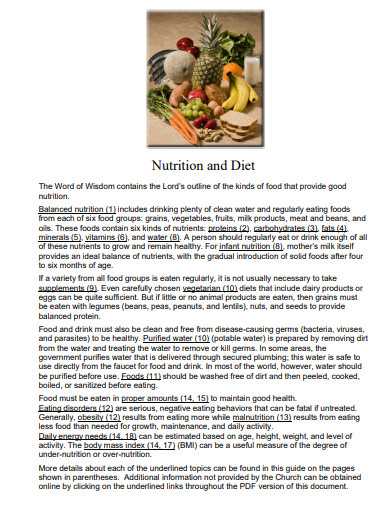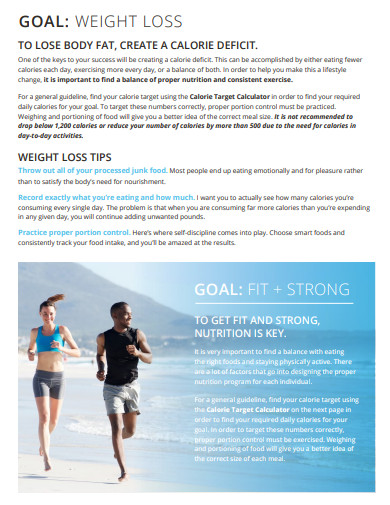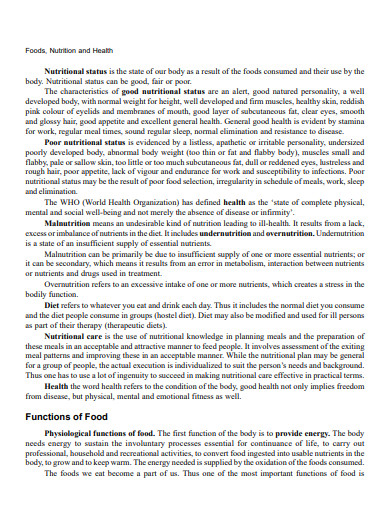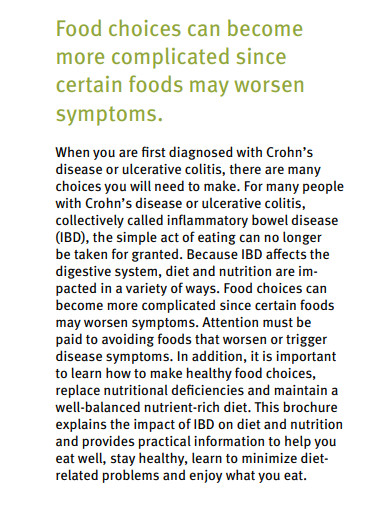Do you feel like you’re tired and sluggish most days? Do you notice your weight changed? Do you notice you don’t look as radiant as you used to be? Do you experience some pains in your body? Do you find yourself getting sick easily? Maybe it has something to do with your diet. Your diet reflects your physical appearance whether you’ve been eating healthy or not. If you notice those undesirable changes in your life, it’s time to step up your diet and focus on eating more healthy food. It starts with creating a diet plan where you incorporate more healthy food into your everyday meals. Read the article to know how to create a nutrition diet plan.
4+ Nutrition Diet Plan Samples
1. Nutrition Diet Plan
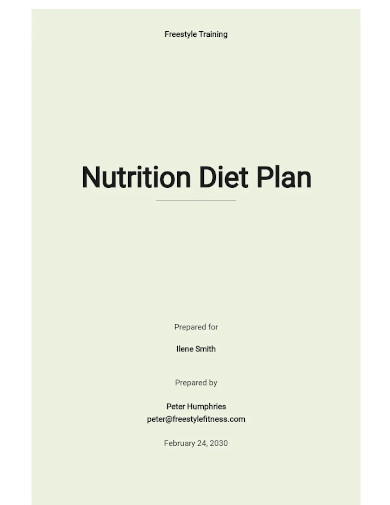
2. Sample Nutrition Diet Plan
3. Simple Nutrition Diet Plan
4. Nutrition Diet Plan Example
5. Nutrition and Diet Plan for Bowel Disease
Tips on Eating Eating Healthy Everyday
- Take your time to eat your meal: Avoid eating faster so your food can properly digest on your stomach.
- Drink water: Avoid drinking beverages with high calories regularly.
- Follow the 80% rule: Eat until you’re 80% full.
- Prepare your meals for the week ahead: This will save you time and effort in thinking about what will be your meal every day.
How to Create a Nutrition Diet Plan
1. Calculate the Macronutrients of Your Meals
To make sure you get all the nutrients you need to fuel yourself up every day by growing your muscles and keeping your energy high, it’s important to measure the number of macronutrients present in all the food you intake. Macronutrients are the basic building blocks, such as carbohydrates, protein, and fat, your body needs to do activities every day without feeling sluggish. You can use a macronutrient calculator online to guide you on how to measure your food effectively.
2. Look for Food That Fit Your Lifestyle
When making a diet plan that includes more nutritious food and at the same time, fits your tastes and budget, start by making a list of the food that you like to eat. If you want to be a little adventurous and want to include food that you don’t usually eat, you can also include that as well. Don’t forget to do step one above to figure out how you can control each food portion that is appropriate for each meal and give you the nutrients you need every day.
3. Make a List of Recipes You Can Use to Cook Your Meals
Now that you figured out what food to eat based on your list, it’s time to look for recipes that feature your food present in the list and at the same time find the ones that fit your preferences. As much as possible, make sure you have a wide variety of recipes that you chose and listed down to make sure you won’t get bored of preparing the same meal every single time. You can also create a list for all restaurants you frequently go to and make sure to measure the macronutrients present in their meals.
4. Set an Eating Schedule and Stick to It
To prevent eating and snacking at various times of the day where you can’t track your food intake, discipline yourself by making an eating schedule where you can follow easily and only eat at those hours. It depends on you on what type of eating schedule you can do, whether eating small meals five times a day or following the traditional three meals a day schedule. However, if you want to control your cravings and lose weight, you need to take note of these guidelines and stick to them:
- Eat a filling dinner in the early evening to avoid late-night snacking and give your digestive system to digest your food before you sleep.
- Consume a high-protein breakfast in the morning.
FAQs
What is the importance of a healthy diet?
A healthy diet is essential for the overall good health and well-being of a person. Intaking food with lots of nutrients, and avoiding too much salt, sugar, and saturated trans-fats protects a person against many chronic non-communicable diseases.
What are bad eating habits?
Bad eating habits are doing unhealthy eating such as under or overeating, not consuming enough healthy food, and consuming food that is in fat and sugar.
What happens if you dont eat properly?
If you don’t eat properly can cause you to feel tired, get more prone to illnesses, occur hair loss, and suffer skin problems. Overeating and undereating are practices of not eating properly.
To ensure your diet plan is successful, keep a food diary to track your meal plan. This will allow you to analyze your eating habits and check the effectiveness of your plan. Plus, it also helps you track your goal weight. Make sure your diet plan is flexible enough to adjust for any changes in your dietary plan if the former doesn’t provide you with the desired results. To help you get started creating the nutrition diet plan, download our free sample templates above to use as your guide!
Related Posts
FREE 7+ Meal Plan Samples & Templates in PDF MS Word
FREE 5+ Sample Diet Plan Templates in PDF MS Word | Google ...
FREE 8+ Sample Healthy Meal Plan Templates in PDF
FREE 9+ Diet Chart Templates in PDF MS Word | Excel
FREE 19+ Meal Plan Templates in PDF
FREE 10+ Diet Chart Templates in MS Word PDF | Excel
FREE 14+ Sample Weekly Meal Plan Templates in PDF MS Word
FREE 3+ Daycare Meal Plan Samples in PDF MS Word | Apple ...
FREE 9+ Daily Plan Samples in PDF MS Word
FREE 13+ Sample Diet Menu Templates in AI MS Word | Pages ...
FREE 14+ Printable Meal Planner Samples & Templates in PDF
FREE 21+ Meal Planner Samples & Templates in PSD Excel | PDF ...
FREE 6+ Sample Blood Type Diet Chart Templates in PDF
FREE 10+ Diet Chart Templates in MS Word PDF | Excel
FREE 14+ Sample Weekly Meal Plan Templates in PDF MS Word

